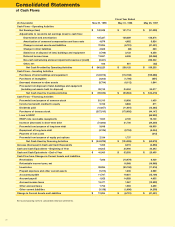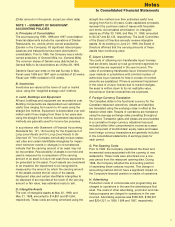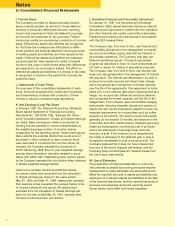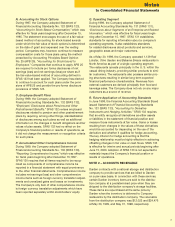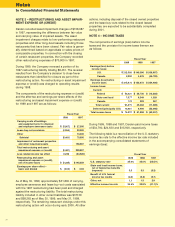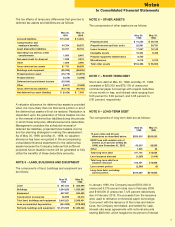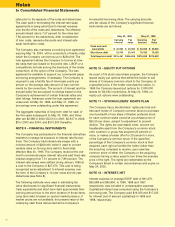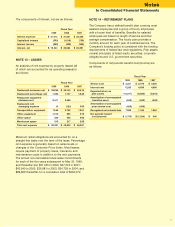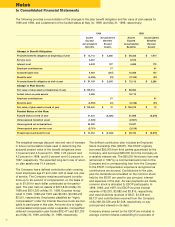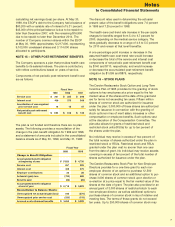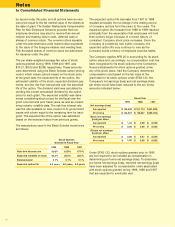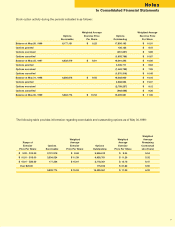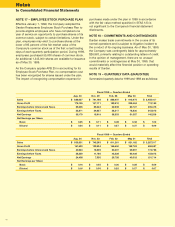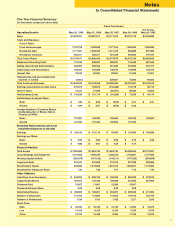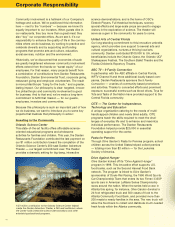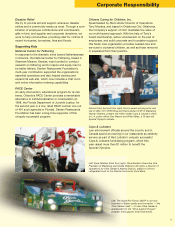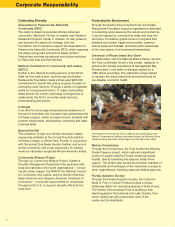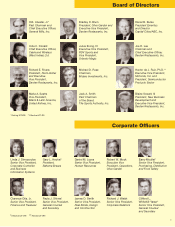Red Lobster 1999 Annual Report Download - page 19
Download and view the complete annual report
Please find page 19 of the 1999 Red Lobster annual report below. You can navigate through the pages in the report by either clicking on the pages listed below, or by using the keyword search tool below to find specific information within the annual report.
Notes
to Consolidated Financial Statements
40
be issued under this plan, and all options have an exer-
cise price equal to the fair market value of the shares at
the date of grant. The Darden Restaurants Compensation
Plan for Non-Employee Directors provides that non-
employee directors may elect to receive their annual
retainer and meeting fees in cash, deferred cash or
shares of common stock. The common stock issuable
under the plan shall have a fair market value equivalent
to the value of the foregone retainer and meeting fees.
Fifty thousand shares of common stock are authorized
for issuance under the plan.
The per share weighted-average fair value of stock
options granted during 1999, 1998 and 1997 was
$10.21, $8.03 and $2.88, respectively. These amounts
were determined using the Black Scholes option-pricing
mode,l which values options based on the stock price
at the grant date, the expected life of the option, the
estimated volatility of the stock, expected dividend pay-
ments, and the risk-free interest rate over the expected
life of the option. The dividend yield was calculated by
dividing the current annualized dividend by the option
price for each grant. The expected volatility was deter-
mined considering stock prices for the fiscal year the
grant occurred and prior fiscal years, as well as consid-
ering industry volatility data. The risk-free interest rate
was the rate available on zero-coupon U.S. government
issues with a term equal to the remaining term for each
grant. The expected life of the option was estimated
based on the exercise history from previous grants.
The assumptions used in the Black Scholes model were
as follows:
Stock Options
Granted in Fiscal Year
1999 1998 1997
Risk-free interest rate 5.60% 6.25% 6.70%
Expected volatility of stock 30.0% 25.0% 22.5%
Dividend yield 0.1% 0.1% 0.1%
Expected option life 6.0 years 5.0 years 6.5 years
The expected option-life decrease from 1997 to 1998
resulted principally from a change in the vesting period
of Company options from five years to four years. The
expected option-life increase from 1998 to 1999 resulted
principally from the expectation that employees will hold
their options longer because of a recent history of
consistent Company stock price increases. Since the
Company is a relatively new public company, the
expected option life may continue to vary as the
Company builds a history of employee exercise habits.
The Company applies APB 25 in accounting for its stock
option plans and, accordingly, no compensation cost has
been recognized for its stock options in the Company’s
financial statements for stock options granted under
any of its stock plans. Had the Company determined
compensation cost based on the fair value at the
grant date for its stock options under SFAS 123, the
Company’s net earnings (loss) and net earnings (loss)
per share would have been reduced to the pro forma
amounts indicated below:
Fiscal Year
1999 1998 1997
Net earnings (loss)
As reported $ 140,538 $ 101,714 $ (91,029)
Pro forma $ 134,527 $ 98,047 $ (93,154)
Basic net earnings
(loss) per share
As reported $ 1.02 $ 0.69 $ (0.59)
Pro forma $ 0.98 $ 0.66 $ (0.60)
Diluted net earnings
(loss) per share
As reported $ 0.99 $ 0.67 $ (0.59)
Pro forma $ 0.95 $ 0.65 $ (0.60)
Under SFAS 123, stock options granted prior to 1996
are not required to be included as compensation in
determining pro forma net earnings (loss). To determine
pro forma net earnings (loss), reported net earnings (loss)
have been adjusted for compensation costs associated
with stock options granted during 1999, 1998 and 1997
that are expected to eventually vest.


